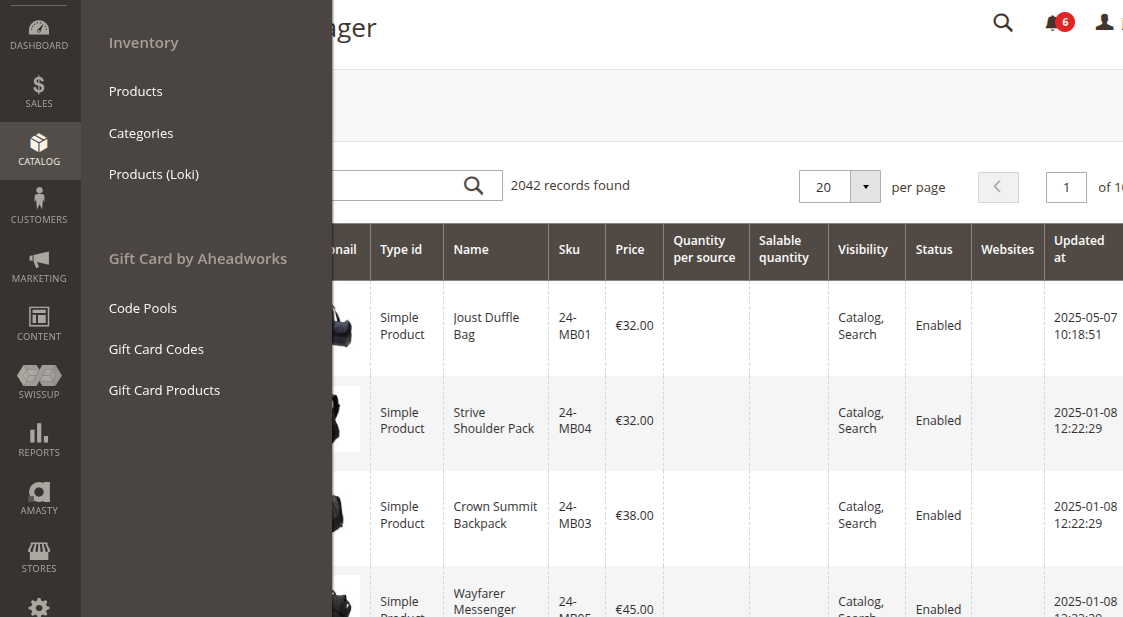yireo / magento2-loki-admin-components
N/A
Installs: 6
Dependents: 2
Suggesters: 0
Security: 0
Stars: 3
Watchers: 1
Forks: 0
Open Issues: 0
Type:magento2-module
Requires
- ext-json: *
- magento/framework: ^102.0 | ^103.0
- magento/module-backend: ^101.0 | ^102.0
- magento/module-catalog: ^102.0 | ^103.0 | ^104.0
- magento/module-customer: ^102.0 | ^103.0
- magento/module-eav: ^100.0 | ^101.0 | ^102.0
- magento/module-ui: ^101.0
- yireo/magento2-loki-components: ^1.0
README
This Magento 2 module allows for developers to build admin grids and admin forms in the Magento 2 Admin Panel in a faster way. No more ugly UiComponents that nobody understands. Create grids and forms quickly. And gradually add features to them, without getting stuck.
The LokiAdminComponents are based on the Yireo LokiComponents module which is also used in the Yireo LokiCheckout. However, this admin tool shows that the Loki suite of Yireo can be applied in many more places.
Note that this library makes use of Alpine.js in the Magento Admin Panel. However, TailwindCSS is not used, we stick to the native Magento Admin Panel classes instead.
Installation
composer require yireo/magento2-loki-admin-components bin/magento module:enable Yireo_LokiAdminComponents Yireo_LokiComponents
Examples
As a demo, you could opt to install the following examples:
- YireoTraining_ExampleLokiAdminProducts - a product repository-based grid with various modifications including inline editing of the product name;
- YireoTraining_ExampleLokiAdminCmsPage - a bare-bones repository-based implementation that is ugly, but it shows what you get with minimal effort;
- YireoTraining_ExampleLokiAdminArrayGrid - a bare-bones array-based grid;
- YireoTraining_YireoTraining_ExampleLokiAdminEavEntityType - a bare-bones collection-based grid to display EAV entity types;
Features
Grid features
- Autodetection of columns
- Search
- Pagination
- Sorting columns
- Custom cell templates
- Inline editing
- Filters
- Mass Actions
- Custom cell templates
- ... (more docs coming soon)
Grid provider handlers
repositorycollectionarray
Form features
- Autodetection of columns
- Field-types (select, text, number, datetime, etc) with option to configure more
- Form actions (Back, Save and Close, Save and Continue, Delete, etc)
- ... (more docs coming soon)
Documentation
See the wiki
Todo
- Easily extend LokiComponent partials via XML layout
- Add file
view/adminhtml/loki/example-grid.xml - Example database query in custom array provider
- Extension Attributes
- Filesystem navigation
- Tiles instead of grid layout
- Delete add confirmation
- Add custom SearchCriteriaBuilder via repository addons
- Switch field for enabled/disabled column within grid
- Export selected to CSV, JSON, XSLX

